Post-purchase emails are an integral part of the customer journey. Most marketing emails boast a 20-25% open rate, but transactional emails can claim an astounding 80-85%! This is because the customer has just made a purchase and is eager to hear from you regarding their order.
By leveraging post-purchase emails, businesses can enhance the customer experience, drive repeat sales, and build stronger relationships with their customers.
In this blog, you will find various examples of post-purchase emails that help maintain a continuous and positive connection with customers. Additionally, you will learn how to set up an effective post-purchase email campaign and implement a series of emails to engage your customers.
What are Post-purchase emails?
Post-purchase emails are sent to customers after they complete a purchase. These emails serve to confirm the transaction, provide shipping and delivery updates, and offer additional information or support.
They can include personalized product recommendations, care instructions, or requests for feedback. The primary goal is to enhance the customer experience and ensure satisfaction with the purchase. Businesses can foster loyalty and encourage repeat purchases by engaging customers through these emails. Post-purchase emails are crucial in customer retention strategies and overall relationship management.
Post-purchase email examples
In this section, we will deep into various post-purchase email examples, each designed to enhance customer satisfaction and drive retention.
1. Order confirmation email
An order confirmation email is a crucial communication sent to customers immediately after they complete a purchase. This email serves several key purposes:
Reassurance and Trust-Building: It reassures the customer that their order has been successfully received and is being processed.
- Order Details: The email typically includes detailed information about the order, such as a list of purchased items, quantities, prices, and the total amount paid.
- Shipping and Billing Information: It provides the customer’s shipping and billing addresses, which allows them to confirm that the information they provide is correct.
- Estimated Delivery Date: Including an estimated delivery date gives customers an idea of when they can expect their order.
- Tracking Information: If available, the email may contain tracking information or a link to track the shipment. This empowers customers to monitor the progress of their delivery in real time.
- Customer Support Contact: Providing contact details for customer support in the email is essential. It gives customers a direct way to address any concerns or issues with their orders.
- Additional Information: The order confirmation email can also include information about return policies, warranty details, and any other relevant terms and conditions.
- Personalization: Personalizing the email with the customer’s name and a thank-you message can enhance the customer experience.
- Cross-Selling and Upselling Opportunities: While the primary focus is on confirming the order, the email can also include suggestions for related products or special offers.
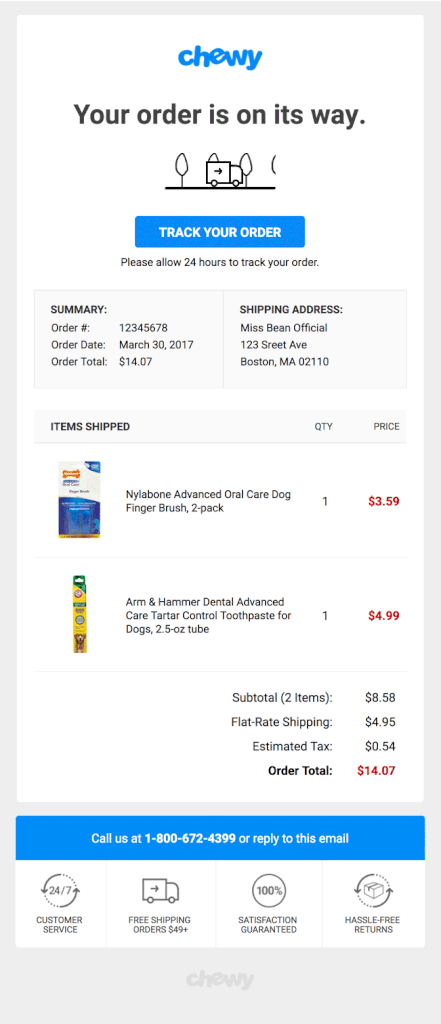
This order follow-up email example from Chewy includes detailed order information, estimated delivery dates, tracking links, and personalized customer support contact information.
2. Thank you email
A thank you email should be sent promptly after purchase to express appreciation and build a positive relationship with your customer. These emails include:
- A sincere thank you note
- Detailed guidance on the upcoming steps
- Concise overview of customers’ purchase
- A polite request for product feedback.
Besides, it may also provide additional value, such as a discount on future purchases or information about related products. By showing appreciation and offering added benefits, thank you emails can enhance customer satisfaction and encourage repeat business.
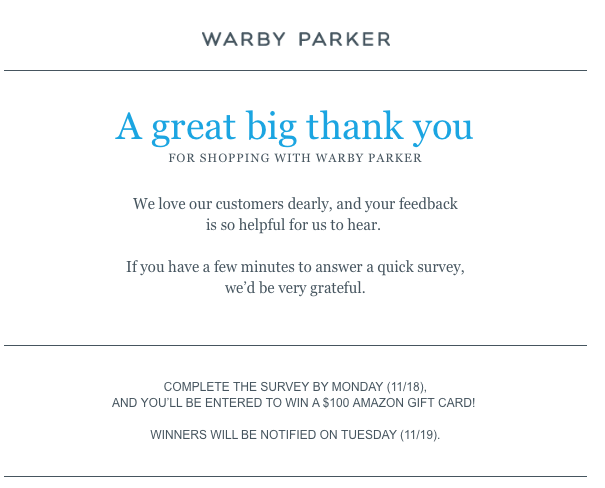
A great example of a thank you email from Warby Parker in expressing appreciation and preparing for the subsequent discussion.
3. Educational / How-to information emails
Send educational or how-to information emails a few days to a week after the purchase, ensuring the customer has received the product and can benefit from valuable guidance on maximizing the use of the purchased product. These emails typically include:
- Step-by-Step Instructions: Provide clear and concise step-by-step instructions on how to use the product effectively.
- Tips and Best Practices: Share tips and best practices for getting the most out of the product.
- Troubleshooting Advice: Include troubleshooting tips to help customers resolve common issues independently.
- Product Maintenance: Offer guidance on product care and maintenance to prolong its lifespan.
- Customer Support Contact Information: Provide easy access to customer support contact details in case customers have questions or encounter difficulties not addressed in the email.
This proactive approach also reinforces the customer’s decision to purchase and strengthens their loyalty to the brand.
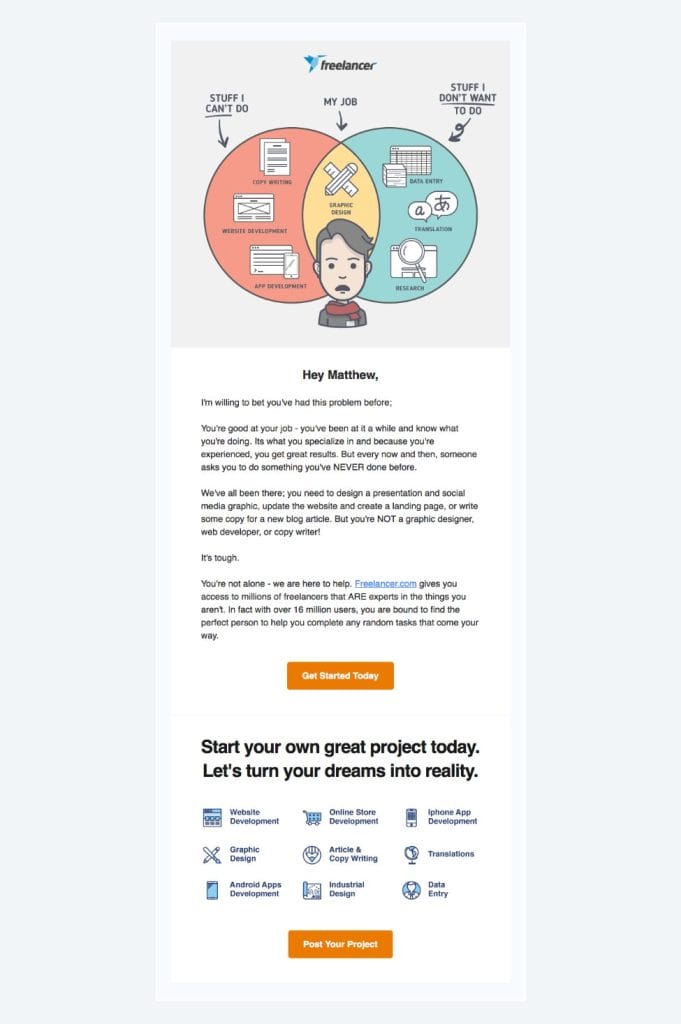
Freelancer helps customer envision their new processes on their platform.
4. Feedback request email
A feedback request email gathers customer insights and improves products and services. So, it is typically sent after a customer has had enough time to use and evaluate the product or service.
This email should be thoughtfully crafted to encourage customers to share their experiences and provide valuable feedback. Not only does requesting feedback show customers that their opinions matter, fostering a sense of connection with the brand but also this engagement can increase customer loyalty and encourage repeat business.
Here are five items to include in a feedback request email:
- Personalized Greeting and Thank You: Start the email with a personalized greeting and thank you message to show appreciation for the customer’s purchase.
- Details: Clearly explain why you are requesting feedback and how it will be used.
- Simple and Direct Call-to-Action: Provide a straightforward call-to-action that directs customers to a feedback form, survey, or review platform.
- Incentives for Feedback: Offer an incentive to encourage customers to provide feedback.
- Follow-Up and Support Information: Let customers know that their feedback will be reviewed and acted upon.
Trustify Review App‘s feature to automatically respond to customer reviews ensures timely engagement, showing customers that their feedback is valued and fostering a positive relationship with the brand.
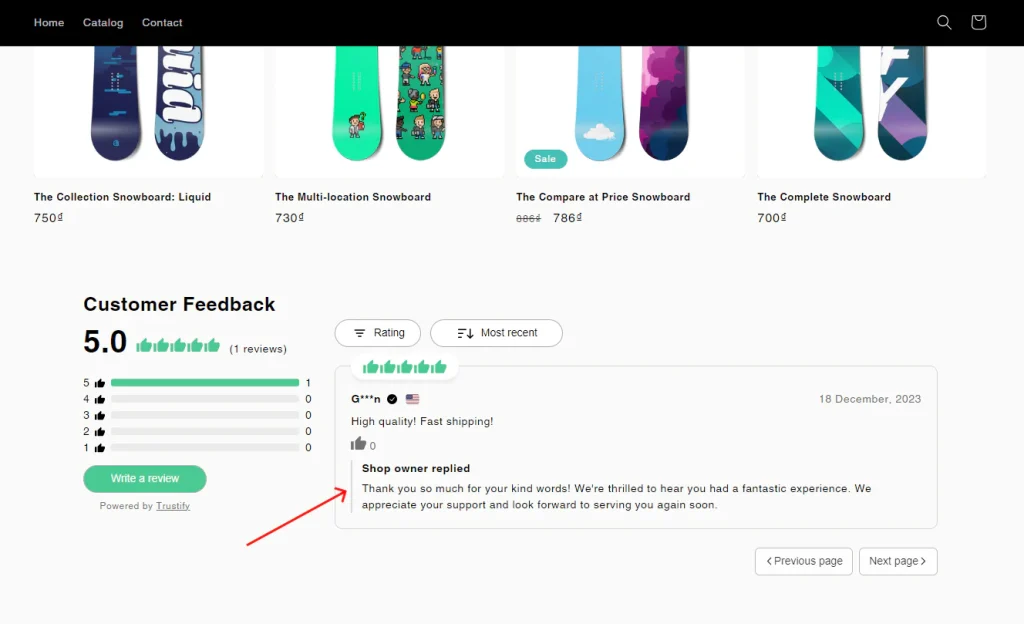
5. Cross-sell and upsell emails
Cross-sell and upsell emails should ideally be sent after the customer has completed a purchase to introduce customers to complementary or upgraded products, thereby increasing average order value, maximizing revenue per customer, and enhancing overall customer satisfaction through personalized recommendations.
5 important factors to add in Cross-sell and upsell emails:
- Complementary Products: Recommend products that complement what the customer has already purchased.
- Upgrade Options: Offer upgrades or premium versions of the purchased product. Highlight the benefits of the upgraded version, such as additional features, better performance, or longer durability.
- Bundle Deals: Create bundle offers where multiple products are packaged together at a discounted price.
- Personalized Recommendations: Use customer purchase history and browsing behavior to personalize recommendations. Tailor the suggestions based on their preferences and previous purchases to increase relevance and likelihood of conversion.
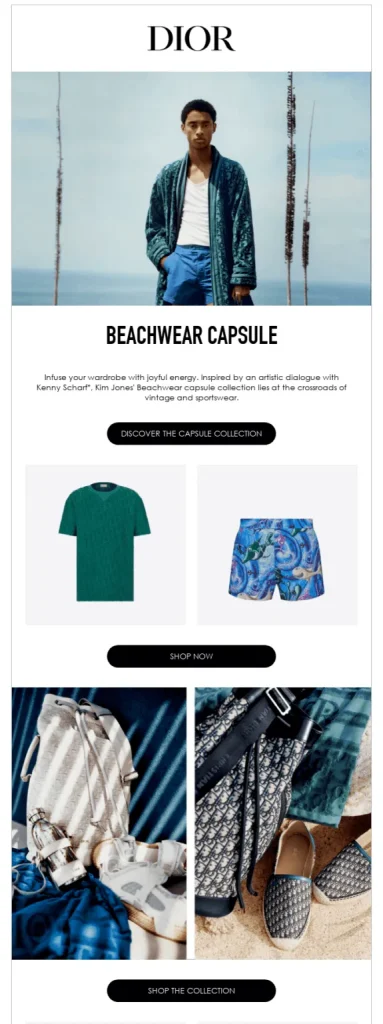
Dior utilizes cross-sell emails to showcase their luxury accessories and complement customers’ recent purchases.
6. Reminder emails
Reminder emails should typically be sent after purchase to ensure customers are aware of important follow-up actions or upcoming events related to their purchase, such as subscription renewals and offer various deals to boost revenue. By strategically using reminder emails, businesses can enhance customer satisfaction, increase repeat purchases, and maintain ongoing engagement, ultimately strengthening their relationship with customers.
When crafting reminder emails, consider including the following elements to effectively communicate with customers:
- Clear Call to Action: Provide a clear and prominent call to action (CTA) that directs customers on what action to take next.
- Important Dates or Deadlines: Clearly state the relevant dates or deadlines associated with the reminder, whether it’s an expiration date, appointment window, or event date.
- Personalization: Personalize the email with the customer’s name and specific details related to their purchase or previous interactions.
- Value Proposition: Reinforce the benefits or value of taking the recommended action.
- Contact Information and Support: Include contact details or links to customer support resources.
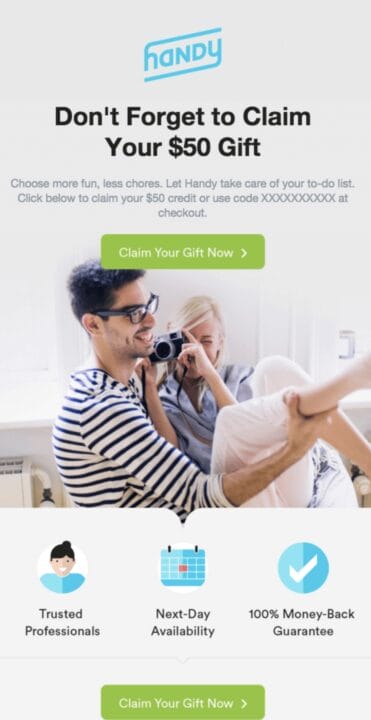
Handy’s reminder email also nudges recipients into action. It highlights the benefits of its services, which include a 100% money-back guarantee.
7. Referral emails
Send referral emails after purchase, ideally when the customer has had a positive experience, and encourage them to refer friends, family, or colleagues to the business. The goal is to capitalize on positive customer experiences to drive word-of-mouth marketing, expand the customer base, and increase sales through trusted recommendations.
This strategy not only expands the customer network but also enhances brand credibility and fosters loyalty by rewarding customers for their advocacy.
Important elements to create perfect referral emails:
- Incentives and Rewards: Offer customers incentives for referring friends, such as discounts on future purchases, cash rewards, or loyalty points.
- Social Sharing Options: Include social sharing buttons in the email to make it easy for customers to share referral links or recommend your products/services on their social networks.
- Personalized Messaging: Tailor the referral email with personalized messages based on the customer’s purchase history or preferences.
- Trackable Links and Analytics: Use trackable referral links in the email to monitor the effectiveness of your referral program. Analyze metrics such as click-through rates, conversions, and new customer acquisitions to optimize your email campaigns.
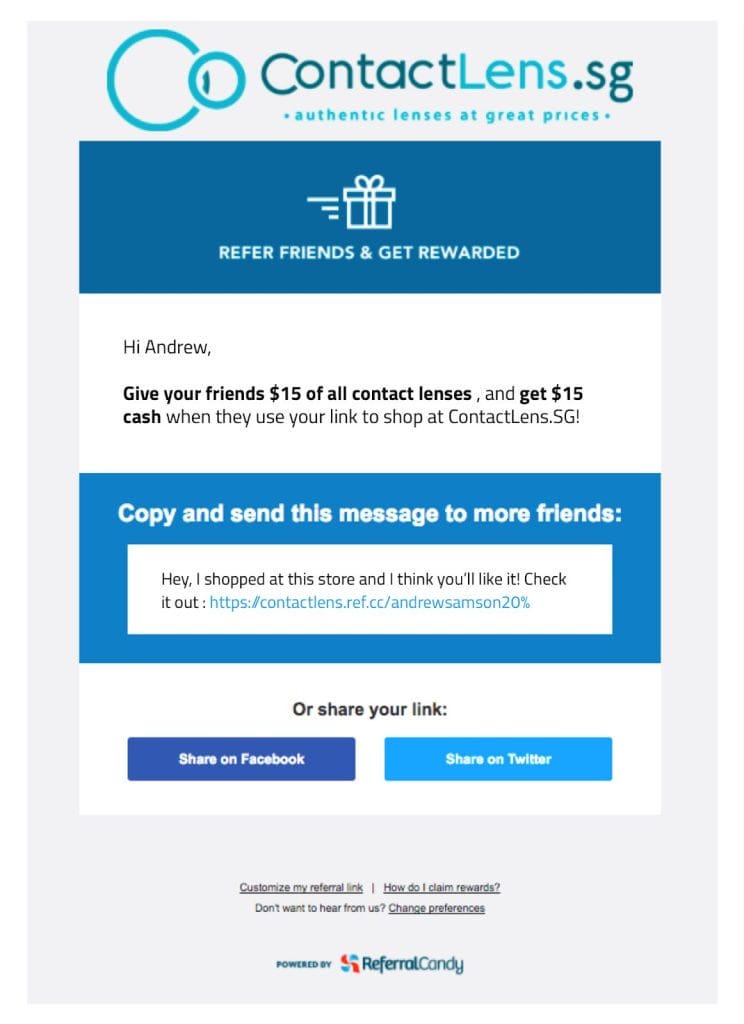
Contact Lens Singapore used ReferralCandy to launch its referral program, where referral advocates earn $15 directly into their PayPal account for each successful referral.
8. Loyalty program invitation emails
Sending loyalty program invitation emails after a purchase is generally a good practice. These emails include communications sent to customers, inviting them to join a company’s loyalty or rewards program such as earning points on purchases, receiving exclusive discounts, or gaining early access to new products. It not only increases customer retention by encouraging repeat business through exclusive rewards but also enhances customer engagement by making customers feel valued and appreciated, thereby fostering long-term brand loyalty.
The following elements to maximize the Loyalty program innovation emails effectiveness:
- Clear Explanation of Benefits: Outline the key benefits of joining the loyalty program, such as earning points, receiving exclusive discounts, accessing special promotions, and getting early access to new products.
- Personalized Invitation: Personalize the email by addressing the customer by name and referencing their recent purchase. Highlight how joining the loyalty program can enhance their experience with the products they’ve already purchased.
- Easy Signup Process: Provide a simple and straightforward signup process with a clear call to action (CTA).
- Exclusive Welcome Offer: Offer an enticing welcome bonus for joining the loyalty program, such as extra points on their next purchase, a discount on their next order, or a special gift.
- Program Details and FAQs: Include a brief overview of how the loyalty program works, along with answers to common questions.
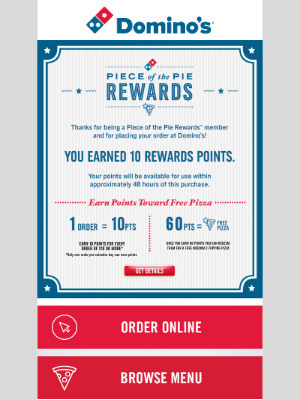
Dominos is a noteworthy example: When a is made, they update the customer on their rewards balance.
9. Win-back emails
Loyalty win-back emails should be sent strategically after a customer’s initial purchase to re-engage lapsed customers and encourage them to return, and make another purchase. These help re-engage inactive customers, reminding them of the value and benefits of your products or services to encourage repeat purchases. By revitalizing interest from previous customers, these emails can boost sales and improve customer retention, ultimately contributing to long-term business growth.
When crafting win-back emails, consider including the following elements to effectively re-engage customers:
- Personalized Messaging: Tailor the email content based on the customer’s purchase history or browsing behavior to make the message relevant and appealing.
- Incentives or Offers: Provide exclusive incentives, such as discounts, free shipping, or special promotions, to entice customers to return and make another purchase.
- Highlight New Products or Updates: Showcase new products, services, or updates since their last purchase to pique their interest and demonstrate ongoing value.
- Clear Call to Action (CTA): Include a clear and compelling CTA that directs customers to take action, such as returning to the website to shop or redeeming a special offer.
- Feedback Request: Encourage customers to provide feedback on their previous experiences to understand their concerns and improve future interactions.
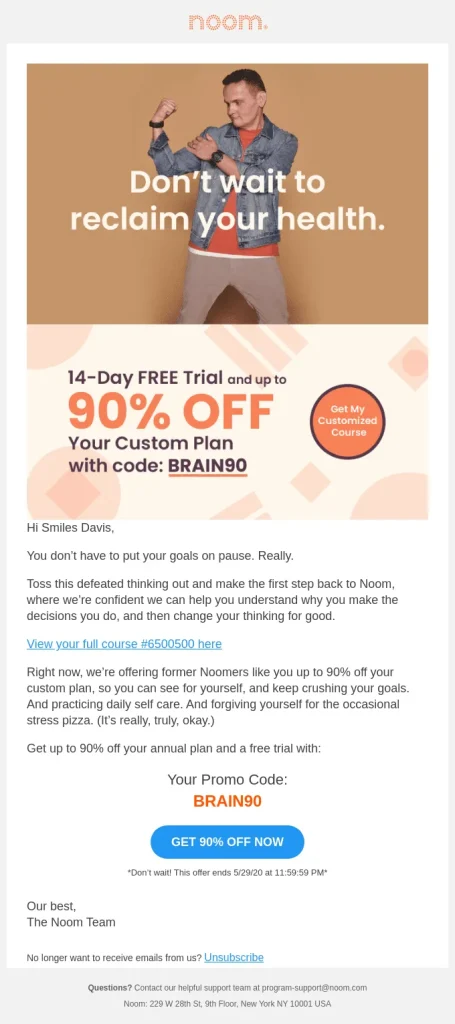
Noom uses Win-back emails with a clear call-to-action to “Don’t wait to reclaim your health” .
How to Create Successful Post-purchase email campaigns?
Creating successful post-purchase email campaigns involves a structured approach to engage customers effectively and drive repeat business.
– Segment Your Audience: Segment your customers based on demographics, purchase behavior, and engagement levels. This allows you to send targeted and relevant emails that resonate with each segment’s preferences and needs.
– Automate Your Emails: Use email automation tools to streamline your campaign. Set up automated workflows triggered by specific actions or events, such as order confirmation, delivery, or purchase anniversary, to ensure timely and personalized communication.
– Craft Compelling Content: Create compelling email content that adds value to the customer. Include order details, shipment tracking information, and personalized recommendations or tips related to their purchase. Use clear and concise language with a compelling call to action (CTA).
– Personalize the Experience: Personalize emails with the customer’s name, past purchase history, or relevant product recommendations based on their preferences. Personalization increases engagement and makes customers feel valued.
– Include Incentives and Offers: Encourage repeat purchases by offering exclusive incentives or discounts. Provide incentives like a discount on their next purchase, a loyalty reward, or free shipping to incentivize customers to return to your store.
– Measure and Optimize: Monitor key metrics such as open rates, click-through rates, conversion rates, and revenue generated from the campaign. Use A/B testing to optimize subject lines, content, CTAs, and timing for better results. Continuously analyze the data to refine your email strategy and improve campaign performance over time.
WRAP UP
Post-purchase emails are integral to nurturing customer relationships beyond the transactional stage. Through this article, by delivering timely and relevant content, personalized recommendations, and incentives, businesses can effectively engage customers post-purchase, encourage repeat business, and ultimately drive growth through increased customer retention and advocacy.
Implementing this well-crafted post-purchase email strategy ensures ongoing engagement and reinforces the value proposition of your products or services in the minds of customers.